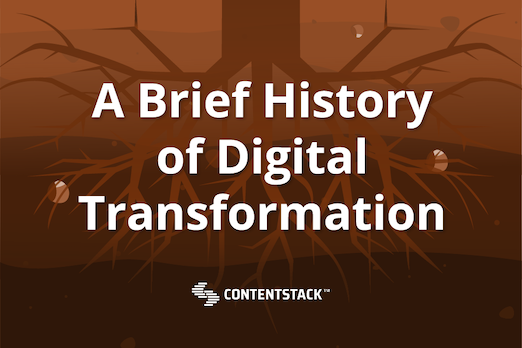A Brief History of Digital Transformation [Infographic]

“Digital transformation” is a relatively new phrase in the lexicon of the modern enterprise, so it may come as a surprise that its roots go all the way back to a revolutionary concept that was born in the middle of the last century—digitization.
Digitization is the conversion of analog technology into a digital format, and it has been disrupting the way we work and live since its conception in the late 40s.
In 1948, American mathematician and engineer Claude Shannon, later dubbed the “father of modern digital communications and information theory,” laid the foundation for what would become digitization in a paper entitled A Mathematical Theory of Communication.
Just one decade later, the microchip and semiconductor transistor that would empower analog computing to go digital were invented—and everything changed.
The 60s brought ARPANET, which was the foundation of the internet as we know it. Then, the 70s and 80s saw digitization skyrocket with the invention of personal computers, the World Wide Web, and automation for the workplace. By the end of the 2000s, digitized cell phones were widespread, the internet population topped 1 billion people, and the digital revolution had gone worldwide.
But as the digitization of formerly manual and analog devices and processes reached saturation, developments didn’t just stop—they transformed.
It all started when digitized channels (like websites and social media) and devices (such as smartphones and even on-location kiosks) allowed companies and customers to connect. The companies soon found themselves in need of a digital process that would not only support these interactions but pull from them data that could be used to create valuable experiences for both the company and the consumer.
To better leverage all their marketing and sales channels, consumer data and experiences, and even internal operations; enterprises started connecting tools and systems in cross-departmental networks. Seeing the demand, software providers began developing digital platforms (think CMS and DXP) that suddenly made it possible to strategically implement digitization throughout an entire organization instead of on a per-project basis.
Thus, digital transformation was born.
At its core, digital transformation (DX) is the cross-departmental effort to reimagine the way a company uses its people, processes, and digital programs to drive new business and revenue in light of changing consumer expectations.
And almost every industry and organization on the planet has been—or will very soon be—revolutionized by its development.
In the age of digital transformation, the new norm is change. Changing technology and consumer expectations will continue to metamorphose entire organizations, verticals, and industries—and those businesses that choose not to participate will be left in the dust.
If you’re interested in learning more about the intertwined history of digitization, the internet, and digital transformation—and why the heck it all matters!—check out our infographic below.

For relevant tips and best practices on digital transformation, subscribe to our Headless CMS blog!
About Contentstack
The Contentstack team comprises highly skilled professionals specializing in product marketing, customer acquisition and retention, and digital marketing strategy. With extensive experience holding senior positions at renowned technology companies across Fortune 500, mid-size, and start-up sectors, our team offers impactful solutions based on diverse backgrounds and extensive industry knowledge.
Contentstack is on a mission to deliver the world’s best digital experiences through a fusion of cutting-edge content management, customer data, personalization, and AI technology. Iconic brands, such as AirFrance KLM, ASICS, Burberry, Mattel, Mitsubishi, and Walmart, depend on the platform to rise above the noise in today's crowded digital markets and gain their competitive edge.
In January 2025, Contentstack proudly secured its first-ever position as a Visionary in the 2025 Gartner® Magic Quadrant™ for Digital Experience Platforms (DXP). Further solidifying its prominent standing, Contentstack was recognized as a Leader in the Forrester Research, Inc. March 2025 report, “The Forrester Wave™: Content Management Systems (CMS), Q1 2025.” Contentstack was the only pure headless provider named as a Leader in the report, which evaluated 13 top CMS providers on 19 criteria for current offering and strategy.
Follow Contentstack on LinkedIn.






.svg?format=pjpg&auto=webp)
.svg?format=pjpg&auto=webp)
.png?format=pjpg&auto=webp)






.png?format=pjpg&auto=webp)


